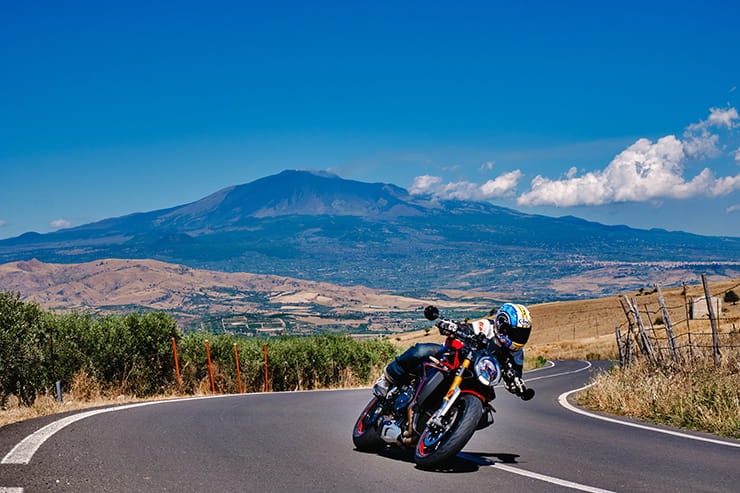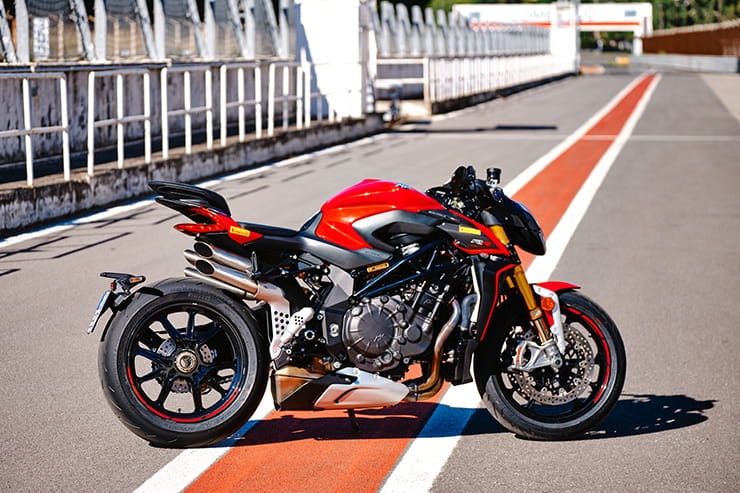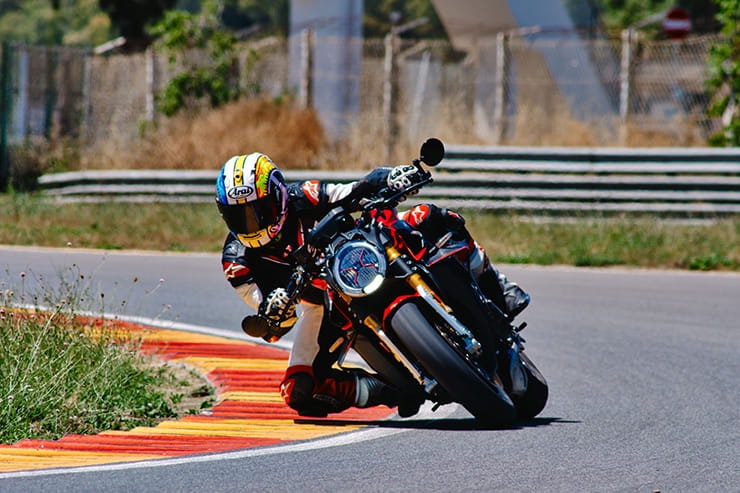MV Agusta Brutale 1000RR (2020) - Review
BikeSocial Road Tester
04.08.2020
Where do I start with the dramatic MV Agusta Brutale 1000RR? It looks like it’s doing a million miles an hour while standing still. I can’t remember a recent bike that is so dramatic, individual and, perhaps because it says MV Agusta on the fuel tank, exclusive. I spent nearly a week with the MV yet was still admiring it and finding new parts to fall in love with when I gave it back. From the front, the distinctive Porsche-like headlights mean it’s immediately identifiable as a Brutale. The cut-away rear seat section featuring four protruding silencers and a sculpted swing-arm combine to make one of the best rear ends on the market… but, like everything exclusive and Italian, the MV comes at a price – an eye-watering £27,290.
It’s not just about the looks, though. The new MV Brutale 1000RR is the most advanced MV to date, and its titanium rodded engine now wants to rev higher and create even more power: a quoted 205 Italian horses. I couldn’t wait to find out if the 2020 Brutale went as fast as it looks, which is why we headed to Italy to find out both on road and track, flicking between Pirelli road and slick tyres to get a real flavour for this Italian beauty.
Image, looks, appeal and exclusivity
Engine performance on track
Handling on track
Poor comfort on the road
Clocks are hard to see
Price, if that’s an issue
2020 MV Agusta Brutale 1000RR Price
Even if you say it quickly, £27,290 is a lot of money, making the Brutale 1000RR the most expensive naked bike on the market. Ducati’s Streetfighter V4 S, arguably MV’s closest competition, also comes with semi-active Öhlins suspension and 205bhp but is just under 20k at £19,795, and Aprilia’s Tuono, also with semi-active suspension, is even cheaper at £17,199. Yes, you could argue the MV has more exclusivity and that with all its carbon and other goodies, is the most eye-catching. But the Ducati is also new for 2020 as well as £6,000 cheaper. Meanwhile, MV dealers up and down the country will be saying, you’re buying into the image, brand and exclusivity. If you want a Rolex, you’ve got to pay Rolex money.
VIDEO REVIEW: MV Agusta Brutale 1000RR (2020)
Two big numbers stand out with this model: 205bhp and £27,190, but just how good is it on road and track?
Power and torque
It’s crazy to think that if you don’t have over 200bhp in the super naked class then you’re turning up to a gunfight with a knife. MV has really pushed the boundaries with the 998cc Brutale now producing a quoted 205bhp at 13,000rpm. To put that in perspective, the new MV is on par with Ducati’s Streetfighter, which, remember, has a larger capacity (1103cc) and way ahead of Aprilia’s Tuono, which produces ‘just’ 173bhp.
That relatively small 998cc capacity and the inherent engine characteristics of an in-line four-cylinder mean that maximum torque – 86ftlb at 11,000rpm – is reasonably high in the rev range, and only bettered by larger capacity bikes in this category. In comparison to other 1000cc naked machines, it’s way ahead.
MV has achieved this impressive output through a series of engine improvements, the main and the most expensive being the introduction of titanium conrods, which allow the engine to spin faster and higher. There are also new valve guides and camshafts, which allow new timings on both the exhaust and intake valves. Lubrication has been improved, and the amount of oil needed for the engine has been reduced.
The screaming inline-four now breathes via a new air-box which is fed from longer air-intakes. And the tuned engine now releases its gases via a stunning four-into-one-into-four exhaust system which is made in partnership with Arrow. There’s new ride-by-wire fuelling with double injectors and four rider modes (Sport, Race, Rain and a Custom mode).
Engine gearbox and exhaust
Thankfully the four-into-one then back-into-four exhaust sounds as good as it looks. MV doesn’t know how to make a bike sound dull. It’s passed Euro-4 homologation yet sounds fantastic. At low rpm there is a distinctive burble, it sounds mechanical, soulful and very Italian, not bland or near-silent like some Japanese bikes. On large throttle openings from low in the revs you can hear the air-box breath, you can feel it gasp for air ready to fire you forward. Dance on the fluid and fast up-and-down quick-shifter, get the revs building and boy does the RR let out a scream. The MV loves to rev, maximum power is at 13,000rpm, but will continue revving a little more. I’d forgotten how much in-line four-cylinder machines enjoy revs and, now with lighter internals like titanium rods and less friction from new pistons, this one is more than willing to sing a high-revving chorus.
However, there is a flip side to all this, and that is the lack of drive and torque lower down in the rev range. Below 6000rpm there isn’t a lot going on and the party doesn’t really get started until 8000rpm. Yes, it will pull away cleanly from low in the rpm but not with any real urgency and it feels somewhat laboured. For rapid acceleration from low speed, exiting a low corner, or for a quick overtake past slow-moving vehicles, you need to flick back a gear or two.
Thankfully the gearbox in partnership with the up-and-down quick-shifter is effortless and smooth but on a few road occasions I felt short-changed and wished I’d knocked it down a gear. Not ideal for the road. While I’m knocking myself off the MV Christmas party list, the fuelling is okay but not perfect (which is what you’d expect for a £27-grand bike). Race mode is too way too sharp and aggressive for the road while Rain feels like you’re towing a caravan. MV has historically had niggles with fuelling, and this has improved hugely over the years, and their fuel injection has improved on every model I’ve ridden but so has the competition for whom fuelling isn’t even an issue.
Arguably, this F4 Superbike-based café racer, complete with bar-end mirrors, was never intended for meandering about on or even for commuting around town. Instead, tuck in, lie on the tank and make it scream. On track, you shouldn’t really let the revs drop below 8000rpm. Simply keep it pinned and ride it like a 600 by only changing gear when you venture near the rev-limiter.
When the revs are in the top third of the range, this is one fast naked. 200bhp was enough to win in British Superbike a few seasons ago, now it’s driving a an unfaired road bike. And when you ride it, hard acceleration doesn’t seem to tail off, it just keeps revving and accelerating. Even when you tap into top it shows no sign of relenting. Occasionally I was seeing 165-170mph on the full-colour digital speed and still accelerating, revs still rising. On track of course!
Mind you, it’s not easy to see the updated TFT dash because it’s too close to the fuel cap, angled up and hard to read. The dropped bars, however, work perfectly at high speeds, and you can get really tucked in, arse wedged against the sculpted pillion seat with toes on pegs. Even at 150mph it was bearable, which is what you can’t say on most hyper-naked bikes.
2020 MV Agusta Brutale 1000RR Economy
As the new MV is Euro-4 homologated, the Italian firm quotes 6.7l/1000km, or around 42mpg. With a 16l fuel tank you’re looking at 140 miles per tank before panic sets in. On test, mpg ranged from low 40s to high 40s, but on track it drank quicker than a University student at happy hour, as you’re always revving it towards the redline to keep it in the power. In the real word, range is going to be around 100 miles before you have to start searching for fuel. Nice of MV to fit cruise control, so gentle touring is an option… ish.
Handling, suspension, chassis, and weight
Like the engine, there are two stories to the chassis and handling. Historically, MV has always scored highly in the handling stakes, especially on the track, but has been let down in real world performance on the road. It’s a similar story for the new 2020 Brutale RR, despite being more user-friendly than ever (if you can call a naked 205bhp superbike ‘friendly’).
It’s still harsh on the road. Even in the softest mapping Sport mode, the Öhlin’s semi-active suspension is unforgiving, especially the rear. The front isn’t too bad – there is the odd jolt over large imperfections – but the rear is noticeably tough. This may be exacerbated by the narrow seat, or the lack of travel/sag in the rear shock – either way it causes uncomfortable jolting over bumps. I opted to soften the settings via the custom mode, which can be done on the dash, or via your phone using the MV Ride App. But again, even with the suspension softened, the rear was improved but still occasionally firm. On billiard table-smooth surfaces, up in the mountains on stunning roads which surround Mount Etna, it is not a problem. But in town and on poorly surfaced roads it became a painful issue. Even on the motorway, I had to occasionally lift my bum off the seat to ease the pain whilst crossing poor over-banding on bridges.
Again, you could reason that few owners will be riding a new £27k MV around town, and that it belongs on mountain passes and fast smooth roads. And yes, the front-end feeling is good with a nice connection and feel as you roll into a corner. The racy, dropped bar position feels more natural at speed, and encourages you to hang off the inside. But then you hit a series of bumps and the rear jolts and you lose the confidence to push on, despite the excellent rider aids keeping you safe.
On the track where the surface is consistent and bumps are kept to a minimum, the MV comes together. It works. You can even flick into Race mode, which gives even more suspension support.
On track the new Brutale is in its element and feels like a race bike with the bodywork removed. Ground clearance is huge, the dropped bars allow you to hang off naturally, knee brushing every apex. That huge power combined with taught suspension means the bike feels alive, though never unstable, even at very high speeds. There is a little movement in the bars, but nothing alarming which is impressive for a bike with a short wheelbase and so much drive.
You sit more ‘in’ the bike and out of the wind to a degree, and it’s less physical than most naked bikes – the best compliment I can bestow is that it feels and handles like a race bike with the bodywork removed. Everything works: peg positions, rear seat hump… you can really tuck in carry enormous corner speed with no fear of understeer like some naked bikes which push the front. Excellent.
Brakes
All the ingredients are there: huge grip generated by Pirelli rubber, high quality Öhlins 43mm semi-active forks, and the very latest Brembo Stylema Monobloc 4-piston calipers grabbing 320mm discs, all backed up with cornering ABS. On the road, just a brush of the span adjustable lever is enough to haul it up with precision and feel, but on the track the ABS is too intrusive and the re-intervention of the brakes is too slow. On the road, dressed in protective jacket and jeans, I never really pushed on hard enough to test the stoppers, and I had no complaints. But on track, the ABS didn’t match the ‘high-tech’ feel of the rest of the bike.
On the track, braking from 160mph plus down to 50mph or less and the ABS was too intrusive and inconsistent. Sometimes there was a faint judder or pulsing in the lever, occasionally when a few bumps were thrown in to test the set-up is was a little more. I wanted to brake deep into the apex, trailing the brakes but the ABS, with this inconsistency, wouldn’t allow me to do this.
Rider aids and extra equipment/accessories
As expected and in line with the competition, a 6-axis IMU now sits at the heart of operations, and communicates with the traction control and ABS braking. There are 8-levels of TC, which can also be de-activated, again via the dash or your phone on the MV app. MV now call their anti-wheelie ‘front lift control’, and is remarkably similar. However, rather than dramatically cutting the power when the front wheel lifts from the road/track it will now hover slightly, otherwise the forks will extend dramatically, while power is reduced to ‘hold’ the wheelie rather than dramatically cutting the power causing pitching as the front drops back to the track. There is also launch control as standard, plus that up-and-down quick-shifter and cruise control on the right bar.
The rider aids, particularly the traction control, are excellent. On track, you don’t ‘feel’ them working, which is usually an indication of a smooth system. It’s worth noting that on track we ran Pirelli slicks and, on the road, conditions were perfect, this time grippy Pirelli Diablo Rosso tyres doing the work. It will be interesting to see how the rider aids perform in less favourable conditions in winter. And as mentioned before, the full-colour TFT dash is lovely to look at and reasonably easy to navigate but on the move is too close to the rider and reflects the sunlight badly. This also makes it hard to see which mode you’re in and how much TC you’ve added or removed.
Rivals
2020 MV Agusta Brutale 1000RR Verdict
There is so much to love and appreciate about MV Agusta’s new Brutale 1000RR. The styling, for starters, is unique and sculpted like a work of art. It’s exotic, and owners will be buying into a unique brand.
It is certainly the best MV Brutale to date with huge power and thrilling engine performance towards the last third of the rev range. It handles like a race bike without bodywork and the rider aids are the finest to grace an MV to date. On track it is wonderful to ride – exciting and involving – but there are drawbacks. On the road the rear is too harsh, even when you soften the electronic Öhlins suspension, the fuelling is a little harsh and the TFT dash, though attractive, is positioned too close to the rider. And we’ve not mentioned the price. Yes, we always expect an MV to be slightly more than the competition, but close to £10,000 more than an Aprilia Tuono is a big pill to swallow.
So yes, there is a lot to applaud. MV have clearly done their homework and have made a stunning-looking naked that works superbly on the track. Would I love to own one? Yes, but only for long enough to make my friends envious. Would I purchase one over the cheaper, more road-focused competition? Sorry, no.
2020 MV Agusta Brutale 1000RR Specs
What is MCIA Secured?
MCIA Secured gives bike buyers the chance to see just how much work a manufacturer has put into making their new investment as resistant to theft as possible.
As we all know, the more security you use, the less chance there is of your bike being stolen. In fact, based on research by Bennetts, using a disc lock makes your machine three times less likely to be stolen, while heavy duty kit can make it less likely to be stolen than a car. For reviews of the best security products, click here.
MCIA Secured gives motorcycles a rating out of five stars, based on the following being fitted to a new bike as standard:
· A steering lock that meets the UNECE 62 standard
· An ignition immobiliser system
· A vehicle marking system
· An alarm system
· A vehicle tracking system with subscription
The higher the star rating, the better the security, so always ask your dealer what rating your bike has, and compare it to other machines on your shortlist.
Looking for motorcycle insurance? Get a quote for this motorbike with Bennetts bike insurance


